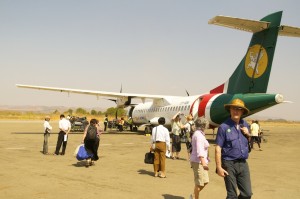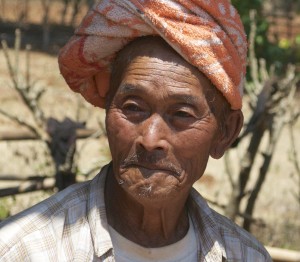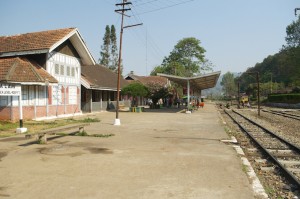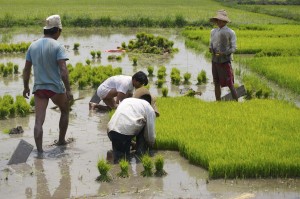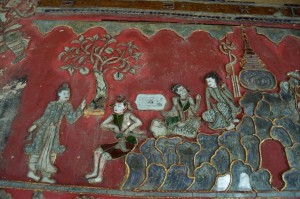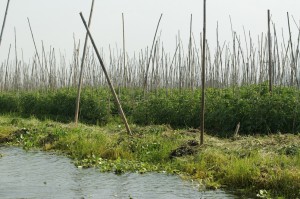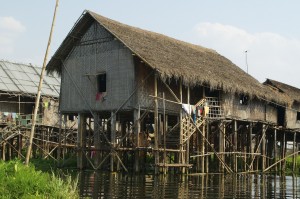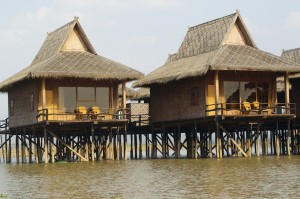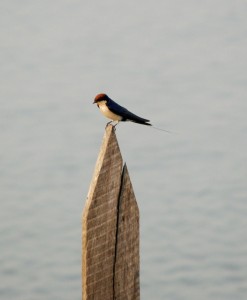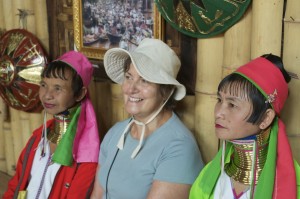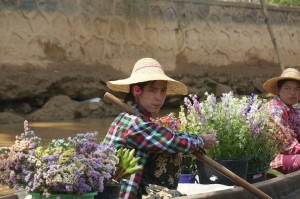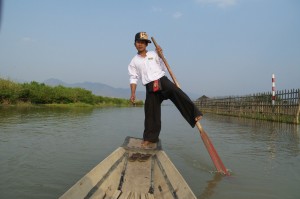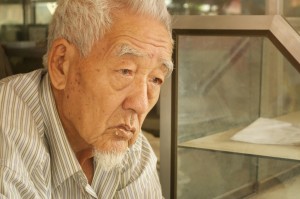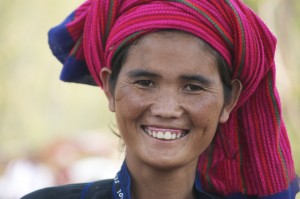A twenty-five minute flight took us from Mandalay to Heho on the very efficient Yangon Airways. It is the same flight we have taken each time we have moved from one area to another as it flies in a loop. This time we flew at 11,000 feet because, as we headed east the land rose up to meet us. Everywhere was parched, red earth, a patchwork of fields now harvested and being prepared for the next growing season when the monsoon rains come.
We are now in Shan State, the largest state by area with a population of about six million. For many years there was unrest here as they wanted autonomy but that dispute was sorted in 1990. Being adjacent to the Chinese, Laos and Thai borders it is fairly sensitive. Agriculturally it is very prosperous and this us evident in the houses they live in. There has been a housing revolution in recent years as they have moved from the traditional woven house to brick built, two storey houses. Agriculture is the mainstay of the people as the land if fertile and they are prepared to work hard. For a very few, part of that wealth may be attributed to the growing of opium, which is illegal but very difficult to control. There seems to be a stronger military presence here, possibly a throwback to the old days but there are problems with child trafficking that they are trying to combat. Children are trafficked for the Thai sex trade, for Chinese second wives and for organs. There are some evil people in the world!
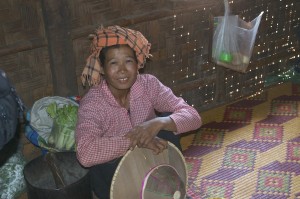 We were not going to Lake Inle straight away but were travelling to see a cave with ten thousand Buddha statues of all sizes in it. It was a couple of hours drive from Heho along a narrow road through farmland. En route we stopped off at a village to get a closer look at how they lived. There were few people around and we discovered that nearly all the villagers had gone to an umbrella ceremony, the topping out of a pagoda. Those that remained had chosen not to go. Again we were greeted with nothing but friendliness with one woman insisting we have a look in her house. She said that next time we come we would be able to see her new, brick built house that was nearing completion behind her present bamboo screen house.
We were not going to Lake Inle straight away but were travelling to see a cave with ten thousand Buddha statues of all sizes in it. It was a couple of hours drive from Heho along a narrow road through farmland. En route we stopped off at a village to get a closer look at how they lived. There were few people around and we discovered that nearly all the villagers had gone to an umbrella ceremony, the topping out of a pagoda. Those that remained had chosen not to go. Again we were greeted with nothing but friendliness with one woman insisting we have a look in her house. She said that next time we come we would be able to see her new, brick built house that was nearing completion behind her present bamboo screen house.
We met one man who had just received a visit from a local government officer. He was holding a piece of paper. When asked what it was it turned out to be the rights to his land. Now he could relax. the land he has been working on for most of his life is officially his and he has the piece of paper to prove it. There have been problems over land rights throughout the reign of the military regime, but now he can sleep peacefully at night knowing that what has always been his, is actually his.
Everything about the village was very tidy, everything having a place and organised, a sharp contrast to the litter that we had seen at roadside. I can only assume that most if that came from passing traffic although there did seem to be specific dumping areas, which the wind had spread further. Plastic bags seem to be a real problem and there are plans to ban plastic bags in some areas but it will all take time to filter through and have an effect.
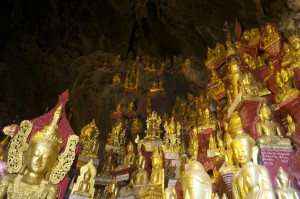 Reaching the Pindaya Caves, we climbed a flight of steps to the entrance where we were faced with a wall of Buddhas disappearing into the roof of the cave. From the entrance it did not look very deep but on entering the walkway snakes between the statues. It is an incredible sight to see so many but it is also a little gaudy. Within the cave there are steps leading up to higher levels and platforms that give different perspectives, and squeezing through a shirt tunnel gains access to a meditation chamber. As you delve deeper into the cave the temperature and humidity suddenly increase. The floor is damp and the air unpleasant to breathe. There are also fewer statues and I am sure that in time all the gaps will be filled with newly sponsored statues and that there is the potential for the number to double to twenty thousand.
Reaching the Pindaya Caves, we climbed a flight of steps to the entrance where we were faced with a wall of Buddhas disappearing into the roof of the cave. From the entrance it did not look very deep but on entering the walkway snakes between the statues. It is an incredible sight to see so many but it is also a little gaudy. Within the cave there are steps leading up to higher levels and platforms that give different perspectives, and squeezing through a shirt tunnel gains access to a meditation chamber. As you delve deeper into the cave the temperature and humidity suddenly increase. The floor is damp and the air unpleasant to breathe. There are also fewer statues and I am sure that in time all the gaps will be filled with newly sponsored statues and that there is the potential for the number to double to twenty thousand.
Leaving the caves we drove to Kalaw, an old colonial town where the British migrated to during the hottest part if the year.
The hotel was a little out if town but was a series of colonial houses and bungalows set in well cared for, weedless gardens. The accommodation was a little rustic but perfectly adequate, particularly as we were only staying one night. The dinner in the wood panelled dining room was good although the green track suit tops of the waiters did not fit with wood panelling. Breakfast was in the outside dining room under a large framed canopy more suited to a tennis court. Parts of breakfast were good but it lacked fruit.
Before we left Kalaw we visited the railway station, stemming from the colonial days with its mock Tudor facade. There are only three trains a day and sadly none came through while we were there. The railways do not have a good reputation and journeys can take a long time and are uncomfortable. From the 1st April tourists will pay the same fair as locals in an effort to entice more people on to the trains.
From the station we went to look at the market in town but it wasn’t as unusual as some of the markets we had been to. It seemed a very quiet and subdued market.
The drive from Kalaw to Lake Inle takes a couple of hours with occasional stops to photograph people working in the rice paddy fields. The fields provided a splash of green in an otherwise earthen landscape. Men, working up to their knees in muddy water, were gathering the young shoots from the nursery beds, putting them into bundles ready for planting out. While men tend to do this task the job of planting out tends to be done by women.
On the outskirts of Nyaung Shwe we stopped at a temple with a thousand small Buddhas housed in niches in the walls with glass work depicting stories of Buddha. The colours were rich and possessed none of the gaudiness of many other temples we had visited. There was a sense of age about the place. The glass work was particularly interesting. I guess it helped in that there were no other visitors there to distract us from looking and admiring.
Adjacent to the temple was a monastery for about thirty novices. They were having a rest, presumably after lunch and were lying in their sleeping quarters away from the heat with all the doors and windows open. As they played games on their phones or game boys they appeared no different to any other young boy.
After our own lunch we went down to the water to meet our three boats and boatmen. The boats were long canoes with an engine attached to a long propeller shaft, which also acted as the rudder. The shaft was not quite as long as the boat we had in Bangkok but the principle was the same.
To access the lake we had to travel down a long wide canal busy with boats going out and returning. Most boats were occupied by tourists but as we entered the lake proper there was a lot more other activity on the lake.
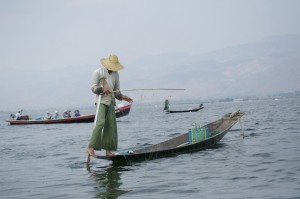 The most amazing were the leg rowing fishermen. To the watcher it seems such a cumbersome firm of propulsion but necessary because of all the things they have to do with their hands. They have small dugout canoes, the front and back being identical with flat platforms. The fisherman stands on one end of the boat with a leg wrapped around a paddle. His hands hold a thin pole and his fishing net, which he gradually plays out as his leg provides the forward motion of the boat. When bringing the net in he tends to squat so that he can extract any fish he may have caught. I couldn’t help but think that such an awkward action must cause hip problems in later life, particularly if they favour only one leg. However, they are equally dexterous with both.
The most amazing were the leg rowing fishermen. To the watcher it seems such a cumbersome firm of propulsion but necessary because of all the things they have to do with their hands. They have small dugout canoes, the front and back being identical with flat platforms. The fisherman stands on one end of the boat with a leg wrapped around a paddle. His hands hold a thin pole and his fishing net, which he gradually plays out as his leg provides the forward motion of the boat. When bringing the net in he tends to squat so that he can extract any fish he may have caught. I couldn’t help but think that such an awkward action must cause hip problems in later life, particularly if they favour only one leg. However, they are equally dexterous with both.
Others were collecting weed from the bottom of the lake and loading it into their canoes so that the weight of it seemed to push the canoe below the surface. Every so often they would bale out the water collecting from their soggy load.
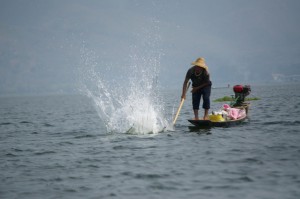 As we neared these people going about their daily business we would cut power so that we could watch and photograph. There are differing styles of fishing. Some, as I have pointed out, played out a long net and then beat the water with their paddle to try to drive the fish into it. Others used a frame with a triangular net and trawled it through the water for a few metres before bringing it up to extract any fish and weed they had picked up. A third method used a conical framed net, which they placed in the water. They then poked a stick into the top and, with a stabbing action, forced the fish into the net where it became entangled. Finally, a fourth group placed bamboo woven tubes into the water to pull up after a given time. These were fresh water prawn traps. All this activity gave us plenty of interest.
As we neared these people going about their daily business we would cut power so that we could watch and photograph. There are differing styles of fishing. Some, as I have pointed out, played out a long net and then beat the water with their paddle to try to drive the fish into it. Others used a frame with a triangular net and trawled it through the water for a few metres before bringing it up to extract any fish and weed they had picked up. A third method used a conical framed net, which they placed in the water. They then poked a stick into the top and, with a stabbing action, forced the fish into the net where it became entangled. Finally, a fourth group placed bamboo woven tubes into the water to pull up after a given time. These were fresh water prawn traps. All this activity gave us plenty of interest.
Leaving the open water the lake becomes a series of channels between floating islands surrounding a stilted village. The floating islands are made up of the weed that has been collected. These islands are held in place by long bamboo poles driven through them and in the mud bed of the lake. Smaller bamboo canes stick into the floating island for row upon row of tomato plants. Tomatoes from this area are the sweetest I have ever had. To break up the monotony of tomatoes vines have been erected for the growing of cucumbers and various types of squash. It is a remarkable system and it is easy to forget that this is still a lake and not a wetland with a network of canals.
The village we travelled through was quite large. Houses protruded from the lake on stilts, many larger than you would expect. The lives of the people revolve entirely around the water – it is their source of food, their income, their water supply and their playground. Children learn to swim at a very early age and they are as comfortable in the water as they are on land. Travelling slowly around the village we were given an insight into their daily life. They even have temples and schools built on stilts and all transport is via the water.
There are twenty-two such villages on or around the lake sustaining the the lives of a great many people. I couldn’t help but think that with the increasing needs of a growing tourist population and the increasing needs of the villagers, there is a danger that the resources of the lake could be stretched in the coming years.
We arrived at our hotel on stilts. Shwe Inn Thar Floating Hotel in the late afternoon. Our boats deftly entered the hotel gateway and deposited us at the teak steps rising out of the water leading to reception and the dining room. From this central hub a series of walkways led to avenues of wooden bungalows beautifully constructed on their stilts. To one side of reception there was a bar overlooking the swimming pool, a remarkable structure suspended above the lake level.
Our bungalow was at the end of an avenue with a perfect outlook to the west, from our balcony, of the setting sun. It is a beautiful location, only spoilt by the regular passage of boats, carrying tourists and locals alike, with their noisy engines.
Having arrived at our hotel we were trapped, unable to venture out to a restaurant, even if we wanted to. There were few other guests as the end if the season approaches so we were well catered for in the restaurant.
In our bungalow there is a notice letting guest know that there is chanting at 4.00am in the monastery in the nearby village. They hoped we would understand and that it would not spoil our stay. Indeed, at the allotted time the microphones chanting could be heard as it drifted across the water. It was quite melodic and not at all disturbing. However, it was obviously the call for all locals to get up and it was not long after that the boats started chugging by. That sound was less pleasant but still had a certain charm about it.
The following morning we had a relatively late start, 9.30, but a full day ahead of us, being transported from place to place by our three boats.
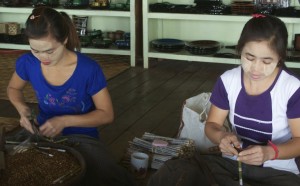 Our first stop was at a cigar making workshop. Again no cigars were being rolled on the thigh of a dusky maiden. A group of five women sat on the floor with all the necessary ingredients and tools in front of them. The tobacco leaves contained a mixture of tamarind, star anise, coconut and a little tobacco. Being paid by volume they can make between 800 and 1000 cigars in a day. We were invited to try one. Not having smoked since 1992 I was a little nervous. It tasted quite nice but immediately made me cough. I will not be taking up the weed again.
Our first stop was at a cigar making workshop. Again no cigars were being rolled on the thigh of a dusky maiden. A group of five women sat on the floor with all the necessary ingredients and tools in front of them. The tobacco leaves contained a mixture of tamarind, star anise, coconut and a little tobacco. Being paid by volume they can make between 800 and 1000 cigars in a day. We were invited to try one. Not having smoked since 1992 I was a little nervous. It tasted quite nice but immediately made me cough. I will not be taking up the weed again.
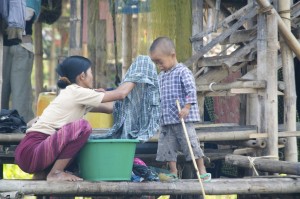 Travelling through the village we were able to observe life from our boat. Nearly everything happens outside, either on the bamboo platforms or on/in the water. People knelt on their platforms washing themselves, pouring water taken from the lake and pouting it over themselves, washing clothes, preparing vegetables, tending their floating vegetable patches from within a canoe or simply watching the world go by. All life is there for everybody to see and I felt privileged to be able to watch it.
Travelling through the village we were able to observe life from our boat. Nearly everything happens outside, either on the bamboo platforms or on/in the water. People knelt on their platforms washing themselves, pouring water taken from the lake and pouting it over themselves, washing clothes, preparing vegetables, tending their floating vegetable patches from within a canoe or simply watching the world go by. All life is there for everybody to see and I felt privileged to be able to watch it.
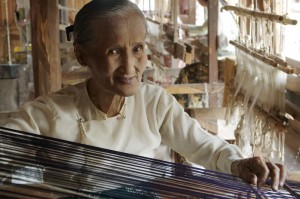 Next we visited a lotus silk workshop. The clatter of looms was quite deafening. All the workers, in three workshops were women, none of them being particularly young and a warning sign that this is a dying craft that will one day be replaced by machines. Young girls prefer to work in restaurants and hotels. You saw each stage of the production from the extraction of the silk from the lotus stalk, the spinning, the dying and finally the weaving. There was a final stage, the shop! Having spent so much time at these two craft centres we had to go for lunch in a stilted restaurant before visiting a pagoda, the most interesting aspect of it being the golden boat that is brought out at festivals. By now we were pretty well pagoderd out and it was interesting that we were spending more time in craft centres and their outlets and less in the religious sights.
Next we visited a lotus silk workshop. The clatter of looms was quite deafening. All the workers, in three workshops were women, none of them being particularly young and a warning sign that this is a dying craft that will one day be replaced by machines. Young girls prefer to work in restaurants and hotels. You saw each stage of the production from the extraction of the silk from the lotus stalk, the spinning, the dying and finally the weaving. There was a final stage, the shop! Having spent so much time at these two craft centres we had to go for lunch in a stilted restaurant before visiting a pagoda, the most interesting aspect of it being the golden boat that is brought out at festivals. By now we were pretty well pagoderd out and it was interesting that we were spending more time in craft centres and their outlets and less in the religious sights.
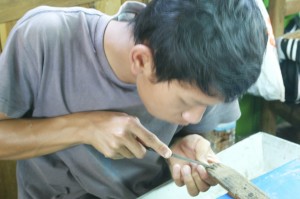 Talking of which we next went to a silver craft workshop where we saw the smelting of the rock to burn out the impurities and leave a silver bar which is then cut and worked into fantastic jewellery and ornamental pieces. There seemed no shortage of young men in the workshop, probably because the pay is commensurate with the skills required.
Talking of which we next went to a silver craft workshop where we saw the smelting of the rock to burn out the impurities and leave a silver bar which is then cut and worked into fantastic jewellery and ornamental pieces. There seemed no shortage of young men in the workshop, probably because the pay is commensurate with the skills required.
The final visit of the day was to the temple of the jumping cat, although cats no longer leap as the abbot felt it was cruel to poke them into jumping. The temple is also renowned for a number of ancient altars. We saw some cats but they weren’t jumping.
Back at the hotel we cooled down in the pool before watching yet another sunset.
I have been having some difficulty with a pair of swallows. Every time I step outside from my stilted room I am dive bombed by the pair. I believe them to have a nest underneath the platform and, for some reason, they consider me to be a threat. They are such skilled flyers, able to divert at the last moment to avoid hitting me but being close enough for me to feel the wind from their wings. I have to force myself to stay still to avoid there being any chance of them hitting me. It would certainly hurt me and would probably kill them. I decided to wear my GoPro and film them. They appear as very fast flashes across the screen. Each time they pass me they tweet a warning. It is wonderful getting so close to nature, or, in reality, nature getting so close to me. I was pleased to discover that I was not their only victim and that others who ventured too near were given the same treatment.
Our last day on Lake Inle was more relaxed with fewer places to visit. The plan was to visit the Five Day Market. That is not a market that lasts for five days but a market that occurs every fifth day. Our boats came to pick us up and take us to the market site. There was a degree of excitement as we were told that there would be some women from the Paduan Tribe, renowned for wearing neck rings. Sure enough, as we stepped out of our boats and went into the shop at the top of the steps, they were there. They were clearly there as a tourist attraction, looking immaculately groomed and willing to pose for photographs. Everything was precise about them, with perfect hair and make-up, poise and long necks encased in a collection of rings. The ones that they were wearing were light weight but on a table were some of the original brass ones which were extremely heavy. The rings gave them an elegance. I wanted to know if they ever took them off. They don’t, although they can if they wanted to. Underneath, their necks would be extremely slender and soft. I was pleased to know that their heads would not flop from lack of strength in the muscles.
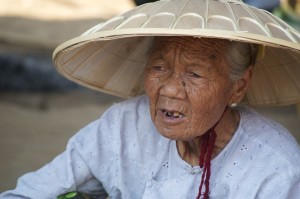 Moving on to the rest of the market, it was clearly geared up for tourists with lots of stalls, in a rectangle, selling mostly tourist trinkets and clothing. A lot of the items were of a good quality and it would be easy to spend a lot of money. There were a few local food stalls in a small section. I was more interested in the people rather than the products as there was such a varied selection or people of all ages and skin textures.
Moving on to the rest of the market, it was clearly geared up for tourists with lots of stalls, in a rectangle, selling mostly tourist trinkets and clothing. A lot of the items were of a good quality and it would be easy to spend a lot of money. There were a few local food stalls in a small section. I was more interested in the people rather than the products as there was such a varied selection or people of all ages and skin textures.
Returning to the shop where we started the women were now more active. I think they were mother and daughter. The daughter was playing a home made guitar and singing a rather monotonous, but captivating song, while the mother was weaving.
Leaving them, we sailed off to visit the Indein Pagoda ruins. To get to Indein we sailed along a canal with far less commercialism and an opportunity to see local people going about their business, men fishing, women paddling canoes laden with flowers, children playing. This was a pleasure to see before hitting the commercial approach to the ruins, a long corridor of stalls up a covered walkway. We managed to avoid their lure on the way up to the pagodas.
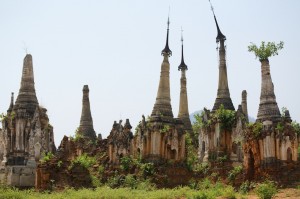 The ruins were spectacularly good, a huge collection of tumbling pagodas with little niches where small statues of Buddha once sat.
The ruins were spectacularly good, a huge collection of tumbling pagodas with little niches where small statues of Buddha once sat.
Closer to the main pagoda a lot of new ones have been, or are still being, built. Only a few have been gilded with gold leaf, the remaining one the natural grey or red depending on the type of plaster they have used. It made a pleasant change not to have everything gilded and, in some respects, I prefer them when they are not.
The return to our boats along the corridor of stalls was less easy with temptation getting in the way of forward progress. Dragging ourselves away from the stalls we returned to the hotel via a lunch stop and had the afternoon free.
In the late afternoon, six of us took three canoes, with a member of the hotel staff each, and went for a paddle around the village. It was very peaceful to be on the water without an engine sputtering behind us, but it was impossible to avoid hearing them as they passed near by. Our paddlers took us through some of the narrow backwaters and although we did not see a great deal in the way of human activity or wildlife, we were taken to places that larger, motorised boats could not reach. Occasionally our oarsmen changed style, preferring to leg row some stretches, particularly when an element of competition entered the fray. It was remarkable what a difference leg rowing made to progress through the water; it was significantly faster. It surprised me that such an ungainly action could be so effective.
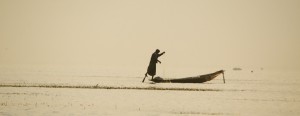 The following morning we were up early for our boats to take us on the hour long journey back to Nyaung Shwe where our bus was waiting to take us to Heho and our flight back to Yangon. The early morning light on the lake was fabulous and for a while the rising sun washed out the colour in the lake, the mountains to the east and the sky, making the early morning fishermen stand out darkly against the light background.
The following morning we were up early for our boats to take us on the hour long journey back to Nyaung Shwe where our bus was waiting to take us to Heho and our flight back to Yangon. The early morning light on the lake was fabulous and for a while the rising sun washed out the colour in the lake, the mountains to the east and the sky, making the early morning fishermen stand out darkly against the light background.
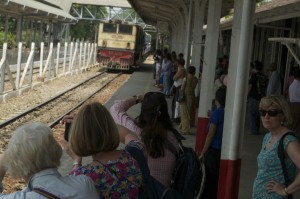 Arriving at the airport an hour before departure we were beginning to relax in the departure lounge when our flight was called. The weather had been particularly clear that morning so all flights had been early, so instead of a 9.30 departure we took off at 8.45. this meant we would be arriving in Yangon much earlier than expected and much too soon for us to go the the hotel. Usa decided we should mix and mingle with the masses and take the train from the nearest station to the airport to the city centre, a journey of about an hour, not really exceeding 25mph.
Arriving at the airport an hour before departure we were beginning to relax in the departure lounge when our flight was called. The weather had been particularly clear that morning so all flights had been early, so instead of a 9.30 departure we took off at 8.45. this meant we would be arriving in Yangon much earlier than expected and much too soon for us to go the the hotel. Usa decided we should mix and mingle with the masses and take the train from the nearest station to the airport to the city centre, a journey of about an hour, not really exceeding 25mph.
Like many railways the world over it was a corridor of deprivation and filth with litter thrown on to the embankments and out of tenement buildings that lined the trackside. Putrid streams of black water oozed its way around the rubbish. We were seeing the worst side of Yangon but it was a thrill to travel on the train in a carriage of bench seats down each side with open windows and no doors. Despite the openness of the carriages it was very hot and sticky. Remarkably, in the space of three hours we had travelled by boat, bus, plane and train.
That was it. We had finished. We had just one more night in Yangon before we split up and took our various routes home.
It has been a fabulous experience. Myanmar is a beautiful country with much to offer. If temples and pagodas are not your thing, they are hard to avoid and you cannot visit Myanmar without visiting a few. It has been a surprise and an eye opener. I really felt that it would not be as advanced as it is, having been ruled by a firm military government for several decades. We had been warned that there would be no ATM machines but there were some, and they worked, and given time there will be many more. They claim to have internet but the service is very limited and, at the moment it is best not to waste time trying. Myanmar is gearing up for more and more tourists with large hotel building projects. They have big plans to renovate all the old colonial buildings in Yangon and the transport infrastructure is being upgraded. A lot hinges on the election next year and whether the constitution can be changed in time for Aung San Suu Kyi to be elected. If it can, she will most certainly be elected and then she will be under pressure to deliver all the social reform the country needs, particularly in education and health. If the constitution cannot be changed in time for her to be elected there might yet be more problems, which could slow down the rate of progress.
The most impressive aspect of this two-week visit has been the people. They are the friendliest people I have ever come across. They welcomed us with open arms and smiling faces wherever we went. We could not have been looked after better. They are a beautiful people, slight in build with stunning facial features. They deserve a peaceful time ahead of them where they can prosper and develop in a way they so richly deserve.
We have focused our attention on the main tourist areas for this trip but it has set the seed for a return visit to go off the beaten track. We will be back!

